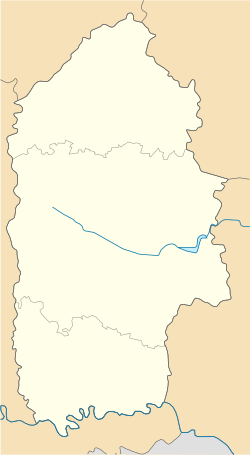Zhvanets (Ukrainian: Жванець) is a village (a selo) in Kamianets-Podilskyi Raion (district) of Khmelnytskyi Oblast in western Ukraine. It hosts the administration of Zhvanets rural hromada, one of the hromadas of Ukraine.[1] The village's population was 1,529 as of the 2001 Ukrainian census.[2]
Zhvanets
Жванець | |
|---|---|
Village | |
 | |
| Coordinates: 48°33′00″N 26°29′15″E / 48.55000°N 26.48750°E | |
| Country | |
| Oblast | Khmelnytskyi Oblast |
| Raion | Kamianets-Podilskyi Raion |
| Hromada | Zhvanets rural hromada |
| Established | 15th century |
| First mentioned | 1431 |
| Area | |
• Total | 2.995 km2 (1.156 sq mi) |
| Population (2001) | |
• Total | 1,529 |
| • Density | 510/km2 (1,300/sq mi) |
| Time zone | UTC+2 (EET) |
| • Summer (DST) | UTC+3 (EEST) |
| Postal code | 32365 |
| Area code | +380 3849 |
| Website | [1] |
History
editŻwaniec, as it was known in Polish, was first mentioned in 1431, when the knight Svychko (or Svichka) received this settlement from Polish King Władysław II Jagiełło.[3][4] It was established in an unpopulated area in the 15th century.[4] Later on, it passed to the Jazłowiecki, Sroczycki, Koniecpolski and Lanckoroński noble families.[3] Administratively it was located in the Podolian Voivodeship in the Lesser Poland Province of the Kingdom of Poland. In the 15th century, the Zhvanets Castle was built, which was repeatedly rebuilt in the 16th and 17th centuries and was significantly destroyed during the 20th century.
In 1620, the Turks and Tatars invaded Podolia having destroyed the fortress. The following year, 40,000 troops led by a Ukrainian Hetman of Zaporozhian Cossacks Petro Konashevych-Sahaidachny joined Zhvanets and took part in the Khotyn War.
In 1646, King Władysław IV Vasa granted Żwaniec Magdeburg rights. It was a private town.
In the autumn of 1653, the troops of John II Casimir Vasa and Bohdan Khmelnytsky met near the city during Khmelnytsky Uprising resulting in the Siege of Zhvanets. In 1672, Ottoman Sultan Mehmed IV invaded and seized the town.[3][4] The castle was converted into a prison for captive Poles, including merchants from Kamieniec Podolski,[5] thus, during the Battle of Chocim of 1673, it was destroyed by the order of John III Sobieski.[3] During the Polish–Ottoman War of 1683–1699, John III Sobieski returned to Żwaniec in 1684, and the armies of Great Crown Hetman Stanisław Jan Jabłonowski and Lithuanian Great Hetman Kazimierz Jan Sapieha joined forces there.[3][6] After the Polish victory in the war, the return of Żwaniec to Poland was confirmed in 1699.[3] After the war, the devastated border town was re-settled by newcomers from Przemyśl and Sanok, Armenians from Kamieniec Podolski and Greeks from Chocim, with the latter two groups specializing in trade.[7] The town was visited by King Stanisław August Poniatowski in 1781.[8][9]
The town was annexed by Russia in the Second Partition of Poland in 1793. A customs chamber was established in the town, which was abolished in 1812.[9] The town was visited by Emperors Alexander I of Russia and Nicholas I of Russia in 1818 and 1843, respectively.[8] In 1920, the town was administratively part of the Podolian District of newly reborn Poland, before it passed to Soviet Ukraine, and afterwards it was located near Ukraine's tripoint with Poland and Romania.
During World War II, it was occupied by Nazi Germany from 1941 to 1944.
Notable people
edit- Corinne Chochem (1905-1990), Jewish American choreographer, born in Zhvanets
- Dov Karmi (1905–1962), architect in British Mandate Palestine and Israel, born in Zhvanets
- Jacob "the Sharp" Halpern (1698-1738), rabbi of Zhvanets and author of many unprinted books. Despite scholastic fame and an 1893 public appeal,[10] his manuscripts (including Beit Yaakov and Megillat Yuhasin) languished in the Odessa home of Joseph Israel Halpern (1840-1928) and have since been lost. Formerly rabbi of Pomoriany, whence he composed a responsum in 1721. His father Tobiah Jehiel Michel Halpern had been rabbi of Belz. His wife was Fradl and his sons included Zeev Halpern and Solomon Isaac Halpern, rabbi of Ternopil.[11][12][13]
See also
editReferences
edit- ^ "Жванецкая громада" (in Russian). Портал об'єднаних громад України.
- ^ (in Ukrainian) Zhvanets
- ^ a b c d e f Słownik geograficzny Królestwa Polskiego i innych krajów słowiańskich, Tom XIV (in Polish). Warszawa. 1895. p. 872.
{{cite book}}: CS1 maint: location missing publisher (link) - ^ a b c Rolle 1880, p. 8.
- ^ Rolle 1880, p. 17.
- ^ Rolle 1880, pp. 17–18.
- ^ Rolle 1880, p. 18.
- ^ a b Rolle 1880, p. 30.
- ^ a b Słownik geograficzny Królestwa Polskiego i innych krajów słowiańskich, Tom XIV. p. 873.
- ^ בלינסון, משה אליעזר (1893). ילקוט משפחות: ... א' אגרת יוחסין למשפחת אלכסנדראוו עם איזה בתי אבות ממשפחות ... תומארקין, פרומקין, קאזארנווער, פריידעש ... (in Hebrew). דפוס מ"א בעלינסאן.
- ^ Eisenstadt, Israel Tobiah (1898). Daʻat ḳedoshim: kolel zikhronot le-toldot ha-mishpaḥot ... ha-mityaḥaśot ... li-ḳedoshim she-masru nafsham ... bi-gezerat ʻalilat dam ... be-Rozinai bi-Medinat Liṭa ... 1659 (in Hebrew). Bi-defus Bermann ṿe-shutafo.
- ^ Scholem, Gershom (March 31, 1961). "The Historical Image of Rabbi Israel Baal Shem Tov". Yiddisher Kemfer (in Yiddish). 42 (1401). Note that this article has been reprinted in Hebrew many times.
- ^ בלינסון, משה אליעזר (1901). שלמי אמוני ישראל: קובץ מאמרים לספרות לשוננו הקדושה (in Hebrew). דפוס איסאקאוויטש ובעלינסאן.



